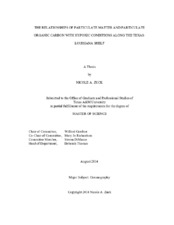| dc.description.abstract | The Mississippi-Atchafalaya river system discharges into the northern Gulf of Mexico and peaks during the spring freshet bringing high levels of nutrients that spur eutrophication in surface waters, often resulting in hypoxic (dissolved oxygen concentrations less than 1.4 mL/L) sub-pycnocline conditions. Hypoxia is generally manifest seasonally along the Louisiana coast over the shelf. In summer 2011, high rainfall in the Mississippi-Atchafalaya watershed caused high discharge into the northern Gulf of Mexico. In summer 2012 drought conditions in the watershed significantly reduced the discharge. Summer 2013 conditions returned to the climatologic average river discharge. Discrete samples were collected and continuous measurements were made via an onboard surface-water flow-through system, CTD casts, and by an undulating towed vehicle. Total particulate matter and particulate organic carbon samples were obtained from Niskin bottles on CTD casts. Samples were also taken to measure dissolved oxygen concentration and nutrients along with other hydrographic parameters. Water-column particulate matter and particulate organic carbon were analyzed to investigate the relationship between hypoxia and the composition of the particulate matter along the Texas-Louisiana shelf during different discharge rates in summer 2011 (for C:N of particulate matter), 2012 and 2013 for a larger suite of particle composition and relationship to hydrographic conditions of the Mississippi-Atchafalaya river system. The goal of this research is to determine if a statistically significant relationship is manifest, between shelf hypoxia and total particulate matter, as well as between particulate organic carbon and hypoxia, during periods of different river discharge (i.e. average, flood, or drought conditions). Correlations were identified between some variables, but no direct relationship between particulate matter and hypoxia was observed. There were however, some statistically significant changes in several parameters between summer 2013 and summer 2013. | en |


